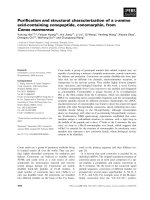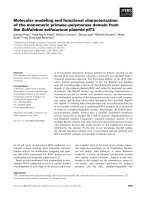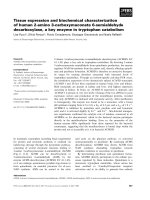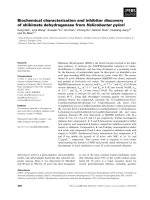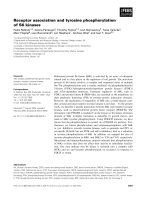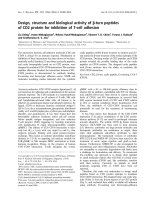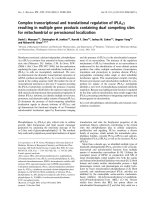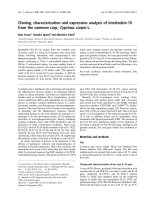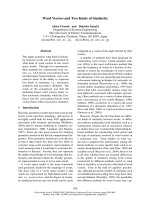Báo cáo khoa học: "Clinical features and therapeutic management of patients admitted to Italian acute hospital psychiatric units: the PERSEO (psychiatric emergency study and epidemiology) survey" pot
Bạn đang xem bản rút gọn của tài liệu. Xem và tải ngay bản đầy đủ của tài liệu tại đây (303.59 KB, 10 trang )
BioMed Central
Page 1 of 10
(page number not for citation purposes)
Annals of General Psychiatry
Open Access
Primary research
Clinical features and therapeutic management of patients admitted
to Italian acute hospital psychiatric units: the PERSEO (psychiatric
emergency study and epidemiology) survey
Andrea Ballerini
1
, Roberto M Boccalon
2
, Giancarlo Boncompagni
3
,
Massimo Casacchia
4
, Francesco Margari
5
, Lina Minervini
6
, Roberto Righi
7
,
Federico Russo
8
, Andrea Salteri
9
, Sonia Frediani
10
, Andrea Rossi*
10
,
Marco Scatigna
10
and the PERSEO study group
11
Address:
1
Servizio Psichiatrico Diagnosi e Cura, Santa Maria Nuova Hospital, Firenze, Italy,
2
Servizio Psichiatrico Diagnosi e Cura, Sant' Anna
Hospital, Ferrara, Italy,
3
Servizio Psichiatrico Diagnosi e Cura, S. Orsola Malpighi Hospital, Bologna, Italy,
4
Clinica Psichiatrica, San Salvatore
Hospital, L'Aquila, Italy,
5
Istituto di Clinica Psichiatrica, Policlinico Consorziale Hospital, Bari, Italy,
6
Dipartimento di Salute Mentale, Azienda
USL 16 Hospital, Padova, Italy,
7
Servizio Psichiatrico Diagnosi e Cura, Hospital of Adria, Rovigo, Italy,
8
Servizio Psichiatrico Diagnosi e Cura,
Nuovo Regina Margherita Hospital, Roma, Italy,
9
Servizio Psichiatrico Diagnosi e Cura, Vimercate Civil Hospital, Milano, Italy,
10
Medical
Department, Eli Lilly Italia, Firenze, Italy and
11
See Appendix for details of participating groups
Email: Andrea Ballerini - ; Roberto M Boccalon - ;
Giancarlo Boncompagni - ; Massimo Casacchia - ;
Francesco Margari - ; Lina Minervini - ; Roberto Righi - ;
Federico Russo - ; Andrea Salteri - ; Sonia Frediani - ;
Andrea Rossi* - ; Marco Scatigna - ; the PERSEO study group -
* Corresponding author
Abstract
Background: The PERSEO study (psychiatric emergency study and epidemiology) is a naturalistic,
observational clinical survey in Italian acute hospital psychiatric units, called SPDCs (Servizio
Psichiatrico Diagnosi e Cura; in English, the psychiatric service for diagnosis and management). The
aims of this paper are: (i) to describe the epidemiological and clinical characteristics of patients,
including sociodemographic features, risk factors, life habits and psychiatric diagnoses; and (ii) to
assess the clinical management, subjective wellbeing and attitudes toward medications.
Methods: A total of 62 SPDCs distributed throughout Italy participated in the study and 2521
patients were enrolled over the 5-month study period.
Results: Almost half of patients (46%) showed an aggressive behaviour at admission to ward, but
they engaged more commonly in verbal aggression (38%), than in aggression toward other people
(20%). A total of 78% of patients had a psychiatric diagnosis at admission, most frequently
schizophrenia (36%), followed by depression (16%) and personality disorders (14%), and no
relevant changes in the diagnoses pattern were observed during hospital stay. Benzodiazepines
were the most commonly prescribed drugs, regardless of diagnosis, at all time points. Overall, up
to 83% of patients were treated with neuroleptic drugs and up to 27% received more than one
neuroleptic either during hospital stay or at discharge. Atypical and conventional antipsychotics
were equally prescribed for schizophrenia (59 vs 65% during stay and 59 vs 60% at discharge), while
Published: 5 November 2007
Annals of General Psychiatry 2007, 6:29 doi:10.1186/1744-859X-6-29
Received: 14 May 2007
Accepted: 5 November 2007
This article is available from: />© 2007 Ballerini et al; licensee BioMed Central Ltd.
This is an Open Access article distributed under the terms of the Creative Commons Attribution License ( />),
which permits unrestricted use, distribution, and reproduction in any medium, provided the original work is properly cited.
Annals of General Psychiatry 2007, 6:29 />Page 2 of 10
(page number not for citation purposes)
atypical drugs were preferred in schizoaffective psychoses (72 vs 49% during stay and 70 vs 46% at
discharge) and depression (41 vs 32% during stay and 44 vs 25% at discharge). Atypical neuroleptics
were slightly preferred to conventional ones at hospital discharge (52 vs 44%). Polypharmacy was
in general widely used. Patient attitudes toward medications were on average positive and self-
reported compliance increased during hospital stay.
Conclusion: Results confirm the widespread use of antipsychotics and the increasing trend in
atypical drugs prescription, in both psychiatric in- and outpatients.
Background
Several countries, mainly in North America and Europe,
have adopted psychiatric units into general hospitals, as
an alternative to the classic psychiatric hospital, for refer-
ral of acute patients with mental illnesses. In Italy, since
1978, the law prescribes that psychiatric patients can only
be admitted to hospitals through these specific emergency
structures, called SPDCs (Servizio Psichiatrico Diagnosi e
Cura, i.e. psychiatric service for diagnosis and manage-
ment). The implementation of this mental health reform
law shifted the focus of care from mental hospitals to
community services. Since their institution, patients
remain in SPDCs only during the acute phase of their ill-
ness. At discharge, they usually receive therapeutic pre-
scriptions and are no longer followed by SPDC structures,
but by territorial services (some of which are specialized
on, e.g., drug addiction, etc), which are not part of the
general hospital system [1]. SPDCs should be the perfect
setting for studying psychiatric patients at their hospital
presentation, however bed shortages, emphasis on acuity
and a continuous emergency situation render it rather dif-
ficult to implement clinical research and epidemiology
programs.
In order to study, from an epidemiological perspective,
the Italian population referring to psychiatric emergency
structures, the PERSEO project – for psychiatric emer-
gency study and epidemiology – was designed. The whole
project consisted of two phases: a pilot phase involving 15
SPDCs, performed in 2002, called the EPICA study (for
epidemiology in psychiatry: acute cases), which collected
preliminary epidemiological information and validated
in Italian the Modified Overt Aggression Scale (MOAS)
and the Nurses' Observational Scale for Inpatient Evalua-
tion (NOISIE) [2]. The second phase consists of the PER-
SEO study, a larger observational multi-centre study
involving 62 Italian SPDCs, aimed at assessing the socio-
demographic and clinical characteristics of patients, their
pathways to psychiatric admission, and describing their
behaviour, subjective wellbeing, management and atti-
tude towards treatment during SPDC stay. Study charac-
teristics and methods have been described in depth in a
previous paper [3]. We were also interested in evaluating
the possible differences between first admission versus
repeated admission patients, also referring to data specifi-
cally concerning first admission patients and their aggres-
sive behaviour, which have recently been the object of a
specific publication [4]. The present paper focuses mainly
on the management of SPDC patients and their attitudes
towards pharmacological treatments.
Methods
PERSEO was designed as a cross-sectional observational
multi-centre study aimed at assessing some epidemiolog-
ical features of patients referring to Italian SPDCs, and in
particular their overall management and psychopharma-
cological treatment in the emergency setting. A total of 62
SPDCs, distributed throughout Italy, participated in the
study. Following approval by the Ethics Committees of
the participant institutions and obtainment of the
patients' written informed consent, all consecutive sub-
jects aged 18 years or more admitted to an SPDC between
September 2003 and April 2004 were enrolled into the
study. All patients were admitted to the study only once
over the enrolment period. The subjects were evaluated at
admission, and then daily for the first 3 days of hospital
stay and at discharge or at day 30, whichever came first.
Psychiatric symptoms were evaluated by the 24 items Brief
Psychiatric Rating Scale (BPRS) [5] and the Brief Symp-
toms Inventory (BSI) [6]. The patients' subjective wellbe-
ing was assessed by the Subjective Wellbeing under
Neuroleptics (SWN) scale [7], while the Drug Attitude
Inventory (DAI-30) [8] was used to measure their attitude
towards the pharmacological treatments. The DAI-30 is a
relatively widely used self-report inventory that focuses on
the subjective effect of antipsychotic medications. To
assess the prevalence of aggressive behaviours, the Modi-
fied Overt Aggression Scale (MOAS) [9], which is the
modified version of the Overt Aggression Scale (OAS),
developed by Yudofski et al [10] and recently validated in
Italian by Margari et al [2], was used.
Sociodemographic and anamnestic data, life habits, risk
factors for psychiatric disease, reason for hospital admis-
sion, referring structure, clinical and psychometric evalua-
tions, concomitant diseases, previous and ongoing
psychiatric treatment, admission and discharge diagnoses,
and treatments administered in SPDC were recorded on
Annals of General Psychiatry 2007, 6:29 />Page 3 of 10
(page number not for citation purposes)
case record forms (CRF). For a full statistical analysis,
patient diagnoses were grouped as described in Table 1.
Project and data management, and statistics were con-
ducted by MediData Studi e Ricerche. Data were analyzed
using SAS for Windows, release 8.2 (The SAS Institute
Inc.). All quantitative variables were described by means,
standard deviations and ranges. Absolute and relative fre-
quency distributions were given for qualitative variables.
Comparisons were performed by Student's t test for mean
values, chi-square test, or Fisher exact test. When multiple
comparisons were performed, Bonferroni's correction was
taken into account. More details on the methodology of
the study can be found in Ballerini et al 2005 [4].
Results
Overall, 2521 patients were enrolled in the 62 participat-
ing SPDCs, with a consequent guarantee of a generous
geographic coverage of the country. As 49 patients were
not viable due to protocol violations or missing data, the
analyses were conducted on 2472 patients (98.1%). Their
sociodemographic characteristics are summarized in
Table 2. Mean age was significantly higher among women
than men (p < 0.001). The percentage of smokers and
alcohol or drug abusers was significantly higher in men (p
< 0.001). Admission was voluntary in 85% of cases, invol-
untary in the remaining 15% of cases; a significantly
higher percentage of women than men were voluntary
admitted (p < 0.001). In addition, marital and occupa-
tional status results were distributed in a statistically dif-
ferent manner between males and females (p < 0.001).
A total of 772 (31.2%) patients were referred by special-
ized structures, either private psychiatrists or public men-
tal health centres, 362 (14.6%) by non-specialized health
professionals (general practitioners or physicians operat-
ing in emergency structures), 340 (13.8%) by other hospi-
tals or rehabilitation structures, while the majority of
patients (998; 40.4%) had not contacted a physician
before admission to an SPDC. Among the reasons for
admission, poor compliance to psychopharmacological
treatment was reported in 44.9% of the overall study pop-
ulation and in 52.2% of subjects presenting with severe
psychiatric symptoms.
A total of 542 (21.9%) patients had no diagnosis at
admission. The diagnoses of the remaining 1930 patients
(78.1%) are summarized in Table 3 (lefthand column). At
discharge from the SPDC, a psychiatric diagnosis had
been established in almost all patients (n = 2407; 97.4%).
The distribution of diagnoses at discharge results were
higher in women than in men for affective diseases and
neurotic disorders, while schizophrenia and substance
abuse were more often diagnosed in men than women
(Table 3, righthand columns).
Table 1: Diagnosis grouping by ICD9-CM code
Diagnosis group ICD9-CM CODES
Schizophrenia 295/295.xx (not 295.7) schizophrenia
Paranoid status and other
non-organic psychoses
297/297.xx Paranoid status
298.2 Reactive confusional status
298.3 Acute paranoid reaction
(delirious bouffee)
298.4 Psychoenic paranoid psic.
298.8 Other reactive psychoses
298.9 SAI psychoses
Affective psychosis, manic
episodes, excitement status
296.0x Single ep. mania
296.1x Recurrent ep. mania
296.4x Affective bipolar sind. manic ep.
296.81 Atypical manic sind
296.6x Affective bipolar sind. mixed ep.
298.1 Agitataed type psy.; psychogen.
excitat.
Affective psychosis,
depression,
296.2 Depr. single ep.
depressive status
296.3x Depr. recurrent ep.
296.5x Bipolar affective sind. depr. ep.
296.82 Atypical depression
298.0 Atyp. psychosis depressive type
311.x Depression not other class.
296.7x Manic-depr. sind circular type
SAI
296.8x (except .81 o .82) Manic depr
sind SAI
296.9x Affective psy. SAI
Schizoaffective psychosis 295.7
Personality disorders 301/301.xx
Neurotic disorders 300/300.xx
Acute stress reactions,
adaptation reactions
308/308.xx/309/309.xx
Substance abuse, dependence 303/303.xx/304/304.xx/305/305.xx
291/291.xx/292/292.xx
Dementia and psycho-organic 290/290.xx dementia
syndromes
293.x Transient organic psychoses
294/294.xx Chronic organic psychoses
310/310.xx Frontal lobe synd. And
other non-
psychotic from brain damage
Mental retardation, infantile
psychoses
314/314.xx/Infant hypercinetc sindr.
315/315.xx/Specific devlopm.
retardation
317/317.xx/Mental retardation
318/318.xx/
319/319.xx/
299/299.xx Infant psychoses, autism
Others 302.x Sexual deviations and disturb.
306.x Physical disfunctions with psych.
origin
307.xx (except 307.1, 307.5)
307.1 anorexia
307.5x other alimentary disturb.
312/312.xx/
313/313.xx/
316
Annals of General Psychiatry 2007, 6:29 />Page 4 of 10
(page number not for citation purposes)
In total, 94% of patients (n = 2325) were viable for the
MOAS and almost half of them (46.4%) had a MOAS
score greater than 0 at admission. The aggressive behav-
iour recorded was most commonly a verbal one (37.8%),
while aggression against other people accounted for
20.5% of patients and aggression against property for
18.3%. Auto-aggression episodes occurred in 15.7% of
cases.
At admission to an SPDC, 66.3% of patients had received
a previous psychopharmacological treatment, as summa-
rized in Table 4 (lefthand column), most frequently
(73.1%) a combination therapy; the most common com-
binations were antidepressants with benzodiazepines
(7.4%) and conventional antipsychotics with benzodi-
azepines (6.2%). Single treatments were 9.0%, and 6.8%
conventional and atypical antipsychotics, 4.9% benzodi-
azepines, 3.4% antidepressants, and 2.8% mood stabiliz-
ers. A psychoactive medication was administered during
SPDC stay to 98.3% of patients and prescribed at dis-
charge to 95.4% (Table 4, middle and right columns).
Consistent with psychiatric diagnoses, antidepressants are
more frequently prescribed for women than men, while
antipsychotics and anticholinergics are more frequently
prescribed for men at any time of data collection. Benzo-
diazepines were more frequently prescribed to women
before SPDC admission but, during hospitalization and at
discharge, this difference reduced to a non-significant
level.
The psychopharmacological treatments prescribed before
admission to the SPDC, during hospital stay and at dis-
charge, stratified per psychiatric diagnosis groups, are
reported in Figures 1 and 2.
The switch rates for neuroleptic therapy were analysed.
Overall, 49% of patients were taking neuroleptic drugs
(either typical or atypical) and 7% received more than one
neuroleptic, before admission to hospital. After admis-
sion to an SPDC, 83% were prescribed neuroleptic drugs
and 27% had a combination of them. The prescription of
atypical antipsychotics increased during SPDC stay for all
diagnostic groups, slightly for schizophrenic patients
(+7%), but much more markedly for manic (+52%) and
schizoaffective (+28%) patients. In addition, conven-
tional antipsychotic prescriptions increased in all diag-
nostic groups during hospital stay, though with a slightly
different pattern: from +14% for schizophrenia up to
+45% for personality disorders. In 74.3% of the patients
who were taking a combination of conventional and atyp-
ical antipsychotics at admission, the combination was
confirmed during hospital stay and/or at discharge. Simi-
larly, 64.5% and 60.6% of the patients who were taking
only atypical and only conventional antipsychotics,
respectively, kept on with the same treatment during hos-
pital stay and/or at discharge. Patients who were not
under neuroleptics at admission started antipsychotic
therapy during hospital stay and/or at discharge, with
atypical only, conventional only, both conventional and
atypical drugs in 22.2%, 28.4%, and 20.4% of cases,
respectively. As shown in Figures 1 and 2, at discharge,
atypical antipsychotics prescriptions were in general con-
firmed, while conventional antipsychotics tended to be
reduced.
Table 2: Sociodemographic characteristics of valuable patients
(n = 2472)
Characteristic Parameter
Females Males
Gender, n (%) 1214 (49.1) 1258 (50.9)
Mean (SD) Females Males
Age 43.7 (14.2) 45.7 (14.3)* 41.7 (13.8)*
Occupational status,
n (%)
Overall Females* Males*
Employed 543 (22.0) 225 (18.5) 318 (25.3)
Housewife 328 (13.3) 325 (26.8) 3 (0.2)
Student 47 (1.9) 19 (1.6) 28 (2.2)
Unemployed 658 (26.6) 249 (20.5) 409 (32.5)
Retired 703 (28.4) 309 (25.5) 394 (31.3)
Disabled 103 (4.2) 40 (3.3) 63 (5.0)
Other 42 (1.7) 21 (1.7) 21 (1.7)
NA 48 (1.9) 26 (2.1) 22 (1.7)
Marital status, n (%) Overall Females* Males*
Single 1079 (43.6) 385 (31.7) 694 (55.2)
Married 564 (22.8) 365 (30.1) 199 (15.8)
Widow 103 (4.2) 83 (6.8) 20 (1.6)
Divorced 271 (10.9) 157 (13.0) 114 (9.0)
NA 455 (18.4) 224 (18.4) 231 (18.4)
Life habits, n (%) Overall Females* Males*
Smokers 1421 (57.5) 542 (44.6) 879 (69.9)
Alcohol abusers 462 (18.7) 149 (12.3) 313 (24.9)
Drug abusers 86 (3.5) 15 (1.24) 71 (5.6)
Admission status, n
(%)
Overall Females* Males*
Voluntary 2103 (85.1) 1073 (88.4) 1030 (81.9)
Involuntary 364 (14.7) 140 (11.5) 224 (17.8)
NA 5 (0.2) 1 (0.1) 4 (0.3)
*Males versus females, p < 0.001; NA: Not available/unknown.
Annals of General Psychiatry 2007, 6:29 />Page 5 of 10
(page number not for citation purposes)
In general, the patients showed improvements from
admission to discharge in their psychotic symptoms, as
evaluated both by psychiatrists (by BPRS) and by the
patients themselves (by BSI). Subjective wellbeing was
evaluated on the SWN scale by 793 patients, with both
admission and discharge questionnaires fully compiled.
SWN was rated by all patients, either with or without
antipsychotics. SWN mean total score increased from
admission to discharge in all antipsychotic treatment
groups: atypical only, conventional only, both conven-
tional and atypical (Table 5). Overall, the patients' atti-
tude towards neuroleptics was positive, as indicated by
the high percentage of patients with a positive DAI-30
total mean score in all treatment groups at admission,
which further increased at discharge (Table 5). At admis-
sion 44% of subjects were receiving psychological support
or had received it within 1 month prior to admission. Psy-
chological support was then administered to 65% of
patients during hospital stay and prescribed at discharge
to approximately 68% of patients.
Table 4: Psychopharmacological treatment before admission to SPDC, during SPDC stay and at discharge. Percentages are calculated
on patients under treatment at admission, during hospital stay and at discharge.
Type of drug At admission n (%) In SPDC n (%) At discharge n (%)
Overall Females Males Overall Females Males Overall Females Males
Benzodiazepine 960 (58.6) 513 (42.3)* 447 (35.5)* 1927 (79.3) 964 (79.4) 963 (76.6) 1604 (68.0) 795 (65.5) 809 (64.3)
Atypical
antipsychotic
700 (42.7) 321 (26.4)† 379 (30.1)† 1215 (50.0) 571 (47.0)† 644 (51.2)† 1222 (51.8) 577 (47.5) 645 (51.3)
Conventional
antipsychotic
690 (42.1) 316 (26.6)† 374 (29.7)† 1268 (52.2) 575 (47.4)* 693 (55.1)* 1046 (44.4) 483 (39.8)† 563 (44.8)†
Antidepressant 591 (36.1) 361 (29.7)* 230 (18.3)* 808 (33.3) 476 (39.2)* 332 (26.4)* 795 (33.7) 464 (38.2)* 331 (26.3)*
Mood stabilizer 509 (31.1) 263 (21.7) 246 (19.6) 764 (31.5) 391 (32.2) 373 (29.7) 774 (32.8) 392 (32.3) 382 (30.4)
Anticholinergic 131 (8.0) 53 (4.4)† 78 (6.2)† 301 (12.4) 119 (9.8)* 182 (14.5)* 261 (11.1) 107 (8.8)§S 154
(12.2)§S
Other 67 (4.1) 28 (2.3)† 15 (1.2)† 215 (8.9) 92 (7.6)* 55 (4.4)* 101 (4.2) 43 (3.5)† 24 (1.9)†
Total no. of
patients on
treatment
1638 (66.3) 825 (68.0) 813 (64.6) 2429 (98.3) 1197 (98.6) 1232 (97.8) 2358 (95.4) 1161 (95.6) 1197 (95.2)
(% of total PERSEO
population)
*Males versus females, p < 0.001; †males versus females, p < 0.05; §males versus females, p < 0.01
Table 3: Diagnoses at admission to SPDC and at discharge. The percentage is calculated on patients with an established diagnosis at
admission and at discharge.
Diagnosis Admission n (%) Discharge n (%)
Overall Females Males
Schizophrenia, paranoid status, other non-organic
psychosis
698 (36.2) 843 (35.0) 342 (28.9)* 501 (41.0)*
Affective psychosis, depression, depressive status 315 (16.3) 401 (16.7) 246 (20.8)* 155 (12.7)*
Personality disorders 268 (13.9) 325 (13.5) 174 (14.7) 151 (12.4)
Affective psychosis, manic episodes, excitement status 176 (9.1) 213 (8.9) 121 (10.2)† 92 (7.5)†
Schizoaffective psychosis 138 (7.2) 164 (6.8) 93 (7.9)† 71 (5.8)†
Substance abuse, dependence 94 (4.9) 135 (5.6) 32 (2.7)* 103 (8.4)*
Neurotic disorders 77 (4.0) 103 (4.3) 69 (5.8)* 34 (2.8)*
Dementia and psycho-organic syndromes 43 (2.2) 78 (3.2) 36 (3.0) 42 (3.4)
Mental retardation, infantile psychoses 29 (1.5) 28 (1.2) 9 (0.8) 19 (1.6)
Acute stress reactions, adaptation reactions 12 (0.6) 47 (2.0) 28 (2.4) 19 (1.6)
Others/NA 80 (4.1) 70 (2.9) 34 (2.9) 36 (2.9)
Total no of patients with diagnosis (% of total
PERSEO population)
1930 (78.1) 2407 (97.4) 1184 (97.5) 1223 (97.2)
*Males versus females, p < 0.001; †males versus females, p < 0.05.
Annals of General Psychiatry 2007, 6:29 />Page 6 of 10
(page number not for citation purposes)
Discussion
PERSEO is a naturalistic, observational study aimed at
assessing the epidemiological and clinical characteristics
of patients admitted to Italian psychiatric units, including
sociodemographic features and life habits, diagnoses,
behaviours, and psychiatric symptoms at presentation, as
well as their clinical management, subjective wellbeing
and attitudes toward medications. To our knowledge,
with 62 SPDC involved and 2521 cases enrolled, the PER-
SEO study represents the largest epidemiological survey
performed in recent years on patients admitted to Italian
psychiatric emergency structures.
Males and females were equally represented in our study
population, but a statistically significant difference was
observed between genders for all of the demographic
characteristics (age, life habits, marital and occupational
status), with females being on average 4 years older than
males. This seems to be consistent with the delayed onset
of psychosis in females as compared to males previously
reported by several authors, in particular for schizophre-
nia, which has been explained by some authors by the role
played by estrogens in modulating serotoninergic func-
tion [11-13]. The percentage of smokers was quite high in
our patient population (57.5%), but this was expected, as
it is well known that psychiatric patients are more vulner-
able to nicotine-dependence and rates of smoking are
Psychopharmacological therapies prescribed at admission, during stay and at discharge from SPDC for main (n = 100) psychiatric diagnoses (manic episodes/excitement status, schizoaffective psychosis, substance abuse/dependence)Figure 2
Psychopharmacological therapies prescribed at
admission, during stay and at discharge from SPDC
for main (n = 100) psychiatric diagnoses (manic epi-
sodes/excitement status, schizoaffective psychosis,
substance abuse/dependence). Percentages are calcu-
lated on patients with at least one psychoactive drug pre-
scribed within each diagnostic group. A patient could be
taking more than one drug at the same time. Schizophrenia
includes paranoid status and other non-organic psychoses.
Manic episodes, excitement status
5%
4%
77%
57%
60%
15%
76%
13%
7%
63%
49%
2%
57%
37%
44%
23%
68%
12%
10%
81%
57%
0%
10%
20%
30%
40%
50%
60%
70%
80%
90%
100%
Benzodiazepine Atypical antipsychotic Conventional
antipsychotic
Antidepressant Mood stabilizer Anticholinergic Other
Admission During stay Discharge
Schizoaffecti ve psychosis
13%
2%
79%
72%
49%
26%
53%
20%
9%
62%
46%
3%
45%
56%
43%
30%
48%
22%
14%
56%
70%
0%
10%
20%
30%
40%
50%
60%
70%
80%
90%
100%
Benzodiaze pine Atypical
antips ychotic
Conve ntional
antips ychotic
Antidepressant Mood stabilizer Anticholinergic Other
Admission During stay Discharge
Substance abuse, dependence
2%
21%
86%
19%
56%
29%
12%
5%
25%
75%
44%
14%
74%
14%
29%
41%
14%
37%
3%
12%
24%
0%
10%
20%
30%
40%
50%
60%
70%
80%
90%
100%
Benzodiaze pine Atypical
antipsychotic
Conve ntional
antips ychotic
Antidepressant Mood stabilizer Anticholinergic Other
Admission During stay Discharge
Psychopharmacological therapies prescribed at admission, during stay and at discharge from SPDC for main (n = 100) psychiatric diagnoses (schizophrenia, depressive episode/sta-tus, personality disorders)Figure 1
Psychopharmacological therapies prescribed at
admission, during stay and at discharge from SPDC
for main (n = 100) psychiatric diagnoses (schizophre-
nia, depressive episode/status, personality disorders).
Percentages are calculated on patients with at least one psy-
choactive drug prescribed within each diagnostic group. A
patient could be taking more than one drug at the same time.
Schizophrenia includes paranoid status and other non-
organic psychoses.
Schi zophreni a
12%
3%
76%
59%
65%
13%
18%
20%
5%
65%
60%
2%
50%
56%
57%
14%
18%
12%
19%
18%
59%
0%
10%
20%
30%
40%
50%
60%
70%
80%
90%
100%
Benzodiaze pine Atypical
antipsychotic
Conventional
antipsychotic
Antidepressant Mood stabilizer Anticholinergic Other
Admission During stay Discharge
Depressive episode/status
4%
4%
83%
41%
32%
77%
32%
4%
12%
73%
25%
6%
28%
73%
25%
35%
66%
44%
33%
5%
80%
0%
10%
20%
30%
40%
50%
60%
70%
80%
90%
100%
Benzodiaze pine Atypical
antips ychotic
Conventional
antips ychotic
Antide press ant M ood stabilizer Anticholine rgic Other
Admission During stay Discharge
Personality disorders
6%
5%
83%
45%
47%
44%
42%
8%
9%
75%
39%
6%
67%
37%
33%
48%
43%
46%
8%
43%
49%
0%
10%
20%
30%
40%
50%
60%
70%
80%
90%
100%
Benzodiazepine Atypical antipsychotic Conventional
antipsychotic
Antidepressant Mood stabilizer Anticholinergic Other
Admission During stay Discharge
Annals of General Psychiatry 2007, 6:29 />Page 7 of 10
(page number not for citation purposes)
about two- to fourfold higher in patients with psychiatric
disorders [14-16]. Conversely, the percentage of drug
abusers was quite low, even though it has been reported
that the prevalence of comorbidity of psychosis and sub-
stance abuse has been rising during the last 10–20 years
and substance use disorders are overrepresented in sub-
jects with schizophrenia and bipolar and bipolar spec-
trum disorders [17-19]. Consistent with literature reports
[20-22], the prevalence of smokers, drug or alcohol abus-
ers in males was statistically higher than in females. Vol-
untary admissions to SPDCs were statistically higher for
females than males.
Both at admission to SPDC and at discharge, the most fre-
quent diagnosis was schizophrenia, followed by depres-
sion and personality disorders; interestingly, there were
no relevant changes in diagnosis during hospital stay,
indicating that patients' mental disorders had already
been well recognized before unit admission. However,
during SPDC stay psychiatric diagnoses were also defined
for almost all patients admitted without diagnosis, with
97.4% of the overall patient population diagnosed at dis-
charge.
It has been known for some time that psychiatric patients,
in particular those affected with schizophrenia, are likely
to engage in acts of aggression [23-25], but the impor-
tance of distinguishing among different types of aggres-
sion has been recently underlined [26]. Many of our
patients showed some type of aggressive behaviour
(46%), but they engaged in verbal aggressive episodes
more commonly (38%) than in aggression against other
people (21%). As per diagnosis, the most frequent diag-
nosis among aggressive patients was schizophrenia, as
already reported in another Italian study by Grassi et al
[27]. The same study reported that most violent patients
had had previous psychiatric admissions (92%). How-
ever, it was shown that no difference in aggressive behav-
iours emerges when comparing our results from the
overall PERSEO population with those reported by Bal-
lerini et al in the subgroup of patients at their first psychi-
atric admission [4].
Comparing the treatments prescribed during hospital stay
and at discharge with those received by the patients before
admission, the most commonly prescribed drugs were
benzodiazepines, independent from psychiatric diagnosis
or presence of aggressive behaviours, at all time points.
Benzodiazepine prescription was statistically higher in
women than in men at admission, but this difference dis-
appeared during hospitalization and at discharge, with a
global increase of use in both genders. Antidepressants, as
expected, were most frequently prescribed for depressive
episode/status and neurotic disorders. The most relevant
change in psychopharmacological therapies observed
after admission to an SPDC was the increase in adminis-
tration of both atypical and conventional antipsychotics.
Up to 83% of patients were prescribed neuroleptic drugs,
and 27% had a combination of them. These percentages
are not in disagreement with those reported by previous
Italian surveys on the use of neuroleptics and other psy-
chotropic drugs in Italian mental health services over the
last decade, with 84% of neuroleptics prescriptions
among psychiatric inpatients (up to 98% among schizo-
phrenics) and 67–75% among outpatients, with 45 and
28% of combination therapies in in- and outpatients
being reported, respectively [28-30]. The rates of prescrip-
tion of conventional and atypical antipsychotics were
quite similar at admission and during SPDC stay, whereas
atypical antipsychotics were slightly preferred as a dis-
charge prescription (Table 4). In particular, atypical and
conventional antipsychotics were equally prescribed for
schizophrenia (Figure 1), while atypical drugs were pre-
ferred in the other diagnostic groups, such as personality
disorders (Figure 1), schizoaffective psychoses or affective
psychoses with manic or even depressive episodes (Figure
2). These data confirm the increasing use of atypical antip-
sychotics reported in several American and Italian phar-
maco-epidemiological studies [31-34] over the last
decade, even though they also seem to indicate that con-
ventional antipsychotics are not being completely
replaced in clinical practice by modern "atypical" antipsy-
chotics, as commented by Gardner et al in a very recent
critical overview [34]. Differences in drug prescription
observed between males and females reflect the different
diagnosis distributions observed. The percentage of
patients receiving combination therapies was quite high
at all time points, thus confirming the widespread use of
polypharmacy, a pattern that seems to have grown consid-
erably over the last three decades [28,30,35], despite
remaining controversial. Many new drugs are available
nowadays, and physicians might be motivated to consider
polypharmacy in an attempt to improve quality of life and
Table 5: Mean score (± SD) at the subjective wellbeing (SWN)
scale and number (%) of patients with positive DAI-30 score at
admission to and discharge from SPDC, in patients treated with
antipsychotics (atypical, conventional or both)
Rating scale Atypical
group
Conventional
group
Mixed
group
SWN
Admission 73.1 (17.4) 76.0 (19.0) 74.6 (18.2)
Discharge 79.8 (16.4) 83.4 (15.9) 84.5 (14.9)
DAI-30 > 0
Admission 249 (68.8) 212 (64.2) 169 (67.6)
Discharge 292 (80.7) 259 (78.5) 197 (78.8)
SWN: possible scores range from 20 to 120, with higher scores
indicating greater wellbeing. DAI-30: a score > 0 indicates a positive
attitude toward pharmacological treatments.
Annals of General Psychiatry 2007, 6:29 />Page 8 of 10
(page number not for citation purposes)
increase efficacy, but some authors have underlined that
polypharmacy can also increase the risk of adverse effects,
drug interactions, non-compliance, and medication errors
[36].
If we compare discharge prescriptions in first psychiatric
admission (FPA) patients, as analysed in our previous
report [4], with non-FPA patients, no significant differ-
ences are observed: benzodiazepines (69% of FPA
patients; 69% of non-FPA patients), atypical (in 51 and
53% of patients respectively) and conventional antipsy-
chotics (in 38 and 46% of patients respectively) were the
most prescribed drugs for both populations, with schizo-
phrenia being the commonest diagnosis in both groups
(31% among FPA patients, 35% in non-FPA patients). By
contrast, mood stabilizers were given in a significantly
lower proportion of FPA cases (21% vs 35% of non-FPA
cases; p < 0.001 with Bonferroni correction for five multi-
ple comparisons), whereas a higher though not significant
percentage of antidepressants (41%) were prescribed to
FPA than to non-FPA patients (34%; p = 0.2 with Bonfer-
roni correction for five multiple comparisons).
An increase in self-referred compliance was observed from
admission to SPDC to discharge, indicating that our
patient population's subjective view of drug treatment
became more positive during hospital stay.
Conclusion
We are aware that this survey suffers from the limitations
of a naturalistic, observational, non-comparative, non-
randomised design; however it offers updated informa-
tion on the clinical characteristics and management of a
considerable population of patients admitted to psychiat-
ric emergency structures spread throughout Italy. With
regard to medications, our results confirm the widespread
use of antipsychotics and the increasing trend in atypical
drug prescription, for both psychiatric in- and outpatients.
Positive data emerged regarding patients' perception of
treatment, a measure that is increasingly considered cru-
cial to improve the use of psychotropic drugs and enhance
medication adherence, which might eventually relate to
the clinical outcome of the disease [34,35].
Competing interests
The study was fully sponsored by Eli Lilly Italy. SF, AR and
MS are current employees of Eli Lilly Italy.
Authors' contributions
AB, RB, GB, MC, FM, LM, RR, FR and AS are members of
the PERSEO study Advisory Board. They all contributed to
the study protocol design, enrolment, and interpretation
of analyzed data and to the review of this paper. SF, AR,
MS are current employees of Eli Lilly Italy, the study spon-
sor. They contributed to the interpretation of analyzed
data and to the writing and review of this paper. Finally,
the members of the PERSEO study group contributed to
patient's enrolment.
Appendix
The PERSEO study group
The following centers have collaborated on the PERSEO
study:
• Barale F, Bonzano A, Scioli R – Neurol. Inst. of Mondino
Pavia
• Bellomo A, De Giorgi A, Cammeo C – Osp. Riuniti Hos-
pital Foggia
• Cao A, Zara B – San Francesco Hospital Nuoro
• Conforti I, Chillemi C – Psychiatric Department Parma
• Dagnino L, Ponzoni M – Ospedali Riuniti Hospital Ber-
gamo
• Della Pietra F, Benettazzo M – Azienda USL 16 Hospital
Padova
• Esposito V, Sposito M – Psychiatric Department Palermo
• Fato M, Signorello G – Hospital department of Ponente
Genova
• Fiorenzoni S, Singali A – Ponte Nuovo Hospital Firenze
• Margari F, Sicolo M – Policlinico Consorziale Hospital
Bari
• Martino C, Leria G – Santa Croce Hospital Torino
• Tavolaccini L, Nigro G – Martini Hospita lTorino
• Russo V, La Rovere R – SS. Immacolata Hospital Chieti
• Righi R, Mazzo M – Hospital of Adria Rovigo
• Rocchetti R, De Martiis L – Umberto I Hospital Ancona
• Rodighiero S, Morello M – Hospital of Monselice
Padova
• Vescera M, Pisciotti DG – Iannelli Hospital Cosenza
• Villari V, Barzegna G – Molinette S. G. Battista Hospital
Torino
• Annicchiarico V, Cosmai MG – Hospital of Venere Bari
Annals of General Psychiatry 2007, 6:29 />Page 9 of 10
(page number not for citation purposes)
• Rossi G, Baraldi EC – Poma Hospital Mantova
• Casacchia M, Ruggiero D – San Salvatore Hospital
L'Aquila
• Galimberti P, Fellini FA – Angelucci Hospital Roma
• Francobandiera G – Civil Hospital Sondrio
• Gaspari D, Turati D – SSS. Trinità Hospital Novara
• Matacchieri B, Moscati G – Hospital Taranto
• Mautone A, Casale M – Hospital of Sant'Arsenio Salerno
• Mellado C, Scaramelli B – L. Sacco Hospital Milano
• Filippo A, Miccichè M – Beato Angelo Hospital Cosenza
• Minervini L, Banzato C – Azienda USL 16 Hospital
Padova
• Orengo S, Alisio G – San Paolo Hospital Savona
• Picci RL, Venturello S – S. Luigi Gonzaga Hospital
Torino
• D'Aloise A, Vaira F – S. Timoteo Hospital Campobasso
• Boccalon RM, Cavrini L – Sant' Anna Hospital Ferrara
• Cogrossi S, Prato K – Osp. Maggiore Hospital Cremona
• Cremonese C, Menardi A – Azienda Hospital Padova
• Parisi M, Mentastro C – Umberto I Hospital Enna
• Prosperini P, Binda V – Magg. della Carità Hospital
Novara
• Romano G, Materzanini A – Mellino Mellini Hospital
Brescia
• Crudele A, Stella G – Hospital of Barletta Bari
• Petio C, Fuà B – Ottonello Institute Bologna
• Laich L, Miori M – Hospital department of Arco Trento
• Salteri A, Catania G – Vimercate Civil Hospital Milano
• Achena M, Fara FM – Hospital of Sassari Sassari
• Padoani W, Compagno S – Hospital of Conegliano Tre-
viso
• Ballerini A, Pecchioli S, Moretti S – S.M.N. Hospital
Firenze
• Bacchi L, Vicari E – Hospital of Partinico Palermo
• Arvizzigno C, Minunni P – F. Iaia Hospital Bari
• Rossi E, Zaiti MF – L. Pierantoni Hospital Forlì Cesena
• Boncompagni G, Selleri MS – O. Malpighi Hospital
Bologna
• Minnai GP, Loche AP – San Martino Hospital Oristano
• Russo F, Antonucci A – Nuovo R. Margherita Hospital
Roma
• Chiurco L, Amendola R – G. Compagna Hospital
Cosenza
• De Giovanni MG, Martano A – V. Fazzi Hospital Lecce
• Borsetti G, Santone G – Umberto I Hospital Ancona
• Pettolino AR, Lisanti F – Umberto I Hospital Foggia
• Parodi A, Ciammella L, Botto G – Villa Scassi Hospital
Genova
• Gillotta S, Florio G – Cannizzaro Hospital Catania
• Fiore F, Santangelo E – A. Landolfi Hospital Avellino
• Fucci G, Ricci M – Psychiatric Department Ravenna
• Ciaramella A, Della Porta A – S. Sebastiano M. Hospital
Roma
• Sittinieri M, D'Asta L – Paternò Arezzo Hospital Ragusa
• Triolo S, Spatola A – ARNAS Civil Hospital Palermo
• Frediani S, Rossi A, Macchi S, Giovannini L, Germani S,
Fabbri L – Eli Lilly Italia, Florence, Italy
• Fiori G (project leader), Sala S (clinical project manager
assistant), Sgarbi S (clinical project manager), Simoni L
(statistics), Zanoli M (clinical data manager) – MediData
Studi e Ricerche s.r.l; c/o Centro Servizi CittàNova Viale
Virgilio 54/U, 41100 MODENA, Italy.
Acknowledgements
This study was fully supported by an educational grant issued by Eli Lilly,
Italy. The authors thank MediData for project management, statistical anal-
yses and medical writing, and Stefania Germani for her support in the study
management.
Publish with Bio Med Central and every
scientist can read your work free of charge
"BioMed Central will be the most significant development for
disseminating the results of biomedical research in our lifetime."
Sir Paul Nurse, Cancer Research UK
Your research papers will be:
available free of charge to the entire biomedical community
peer reviewed and published immediately upon acceptance
cited in PubMed and archived on PubMed Central
yours — you keep the copyright
Submit your manuscript here:
/>BioMedcentral
Annals of General Psychiatry 2007, 6:29 />Page 10 of 10
(page number not for citation purposes)
Written informed consent for study participation and possible publication
of study results was obtained from patients or their relatives.
References
1. Mosher LR: Italy's revolutionary mental health law: an assess-
ment. Am J Psychiatry 1982, 139:199-203.
2. Margari F, Matarazzo R, Casacchia M, Roncone R, Dieci M, Safran S,
et al.: Italian validation of MOAS and NOSIE: a useful package
for psychiatric assessment and monitoring of aggressive
behaviours. Int J Methods Psychiatr Res 2005, 14:109-118.
3. Ballerini A, Boccalon RM, Boncompagni G, Casacchia M, Margari F,
Minervini L, Righi R, Russo F, Salteri A, Frediani S, Rossi A, Germani
S, Fiori G, Sgarbi S, Simoni L: Lo studio PERSEO: evoluzione di
un'indagine sui servizi psichiatrici di diagnosi e cura italiani.
obiettivi e metodologia. Giornale Italiano di Psicopatologia 2006,
12:20-30.
4. Ballerini A, Boccalon RM, Boncompagni G, Casacchia M, Margari F,
Minervini L, Righi R, Russo F, Salteri A, Frediani S, Rossi A, Scatigna
M: Main clinical features in patients at their first psychiatric
admission to Italian acute hospital psychiatric units. The
PERSEO study. BMC Psychiatry 2007, 7:3.
5. Ventura J: Training and quality assurance with the Brief Psy-
chiatric Rating Scale: 'the Drift Busters'. Int J Methods Psychiatr
Res 1993, 3:221-224.
6. Derogatis LR, Melisaratos N: The Brief Symptom Inventory: an
introductory report. Psychol Med 1983, 13:595-605.
7. Naber D: A self-rating to measure subjective effects of neu-
roleptic drugs, relationship to objective psychopathology,
quality of life, compliance and other clinical variables. Int Clin
Psychopharmacol 1995, 10(Suppl 3):133-188.
8. Hogan TP, Awad AG, Eastwood R: A self report scale predictive
of drug compliance in schizophrenics: reliability and discrim-
inative validity. Psychol Med 1983, 13:177-183.
9. Kay SR, Wolkenfield F, Murrill LM: Profiles of aggression among
psychiatric patients. I. Nature and prevalence. J Nerv Ment Dis
1988, 176:530-546.
10. Yudofski SC, Silver JM, Jackson W, Endicott J, Williams D: The
Overt Aggression Scale for the objective rating of verbal and
physical aggression.
Am J Psychiatry 1986, 143:35-39.
11. Szymanski S, Lieberman JA, Alvir JM, Mayerhoff D, Loebel A, Geisler
S, et al.: Gender differences in onset of illness, treatment
response course, and biologic indexes in first-episode schizo-
phrenic patients. Am J Psychiatry 1995, 152:698-703.
12. Joffe H, Cohen LS: Estrogen, serotonin, and mood disturbance:
where is the therapeutic bridge? Biol Psychiatry 1998,
44:798-811.
13. Hafner H: Gender differences in schizophrenia. Psychoneuroen-
docrinology 2003, 28(Suppl 2):17-54.
14. Lasser K, Boyd JW, Woolhandler S, Himmelstein DU, McCormick D,
Bor DH: Smoking and mental illness: a population-based
prevalence study. JAMA 2000, 284:2606-2610.
15. Salin-Pascual RJ, Alcocer-Castillejos NV, Alejo-Galarza G: Nicotine
dependence and psychiatric disorders. Rev Invest Clin 2003,
55:677-693.
16. Kalman D, Morissette SB, George TP: Co-morbidity of smoking in
patients with psychiatric and substance use disorders. Am J
Addict 2005, 14:106-123.
17. Gouzoulis-Mayfrank E: Dual diagnosis of psychosis and addic-
tion. From principles to practice. Nervenarzt 2004, 75:642-650.
18. Levin FR, Hennessy G: Bipolar disorder and substance abuse.
Biol Psychiatry 2004, 56:738-748.
19. Tsuang J, Fong TW: Treatment of patients with schizophrenia
and substance abuse disorders. Curr Pharm Des 2004,
10:2249-2261.
20. Bloor R: The influence of age and gender on drug use in the
United Kingdom – a review. Am J Addictions 2006, 15:201-207.
21. Skorge TD, Eagan TM, Eide GE, Gulsvik A, Bakke PS: Exposure to
environmental tobacco smoke in a general population.
Resp
Med 2007, 101:277-285.
22. Dawson DA: Gender differences in the probability of alcohol
treatment. J Substance Abuse 1996, 8:211-225.
23. Rossi AM, Jacobs M, Monteleone M, Obsen R, Surber RW, Winkler
EL, Wommack A: Violent or fear-inducing behavior associated
with hospital admission. Hosp Community Psychiatry 1985,
36:643-647.
24. Pearson M, Wilmot E, Padi M: A study of violent behaviour
among in-patients in a psychiatric hospital. Br J Psychiatry 1986,
149:232-235.
25. Tardiff K, Marzuk PM, Leon AC, Portera L: A prospective study of
violence by psychiatric patients after hospital discharge. Psy-
chiatr Serv 1987, 48:678-681.
26. Troisi A, Kustermann S, Di Genio M, Siracusano A: Hostility during
admission interview as a short-term predictor of aggression
in acute psychiatric male inpatients. J Clin Psychiatry 2003,
64:1460-1464.
27. Grassi L, Peron L, Marangoni C, Zanchi P, Vanni A: Characteristics
of violent behaviour in acute psychiatric in-patients: a 5-year
Italian study. Acta Psychiatr Scand 2001, 104:273-279.
28. Tibaldi G, Munizza C, Bollini P, Pirfo E, Punzo F, Gramaglia F: Utiliza-
tion of neuroleptic drugs in Italian mental health services: a
survey in Piedmont. Psychiatr Serv 1997, 48:213-217.
29. Tognoni G: Pharmacoepidemiology of psychotropic drugs in
patients with severe mental disorders in Italy. Italian Collab-
orative Study Group on the Outcome of Severe Mental Dis-
orders. Eur J Clin Pharmacol 1999, 55:685-690.
30. Magliano L, Fiorillo A, Guarneri M, Marasco C, De Rosa C, Malangone
C, et al.: Prescription of psychotropic drugs to patients with
schizophrenia: an Italian national survey. Eur J Clin Pharmacol
2004, 60:513-522.
31. Centorrino F, Eakin M, Bakh WM, Kelleher JP, Goren J, Salvatore P,
Egli S, Baldessarini RJ: Inpatient antipsychotic drug use in 1993,
and 1989. Am J Psychiatry 1998, 159:1932-1935.
32. Tempier RP, Pawliuk NH: Conventional, atypical, and combina-
tion antipsychotic prescriptions: a 2-year comparison. J Clin
Psychiatry 2003, 64:673-679.
33. Trifiro G, Spina E, Brignoli O, Sessa E, Caputi AP, Mazzaglia G: Antip-
sychotic prescribing pattern among Italian general practi-
tioners: a population-based study during the years 1999–
2002. Eur J Clin Pharmacol 2005, 61:47-53.
34. Gardner DM, Baldessarini RJ, Waraich P: Modern antipsychotic
drugs: a critical overview. CMAJ 2005, 172:1703-1711.
35. Rittmannsberger H: The use of drug monotherapy in psychiat-
ric inpatient treatment. Prog Neuropsychopharmacol Biol Psychiatry
2002, 26:547-551.
36. Ananth J, Parameswaran S, Gunatilake S: Antipsychotic polyphar-
macy. Curr Pharm Des 2004, 10:2231-2228.

